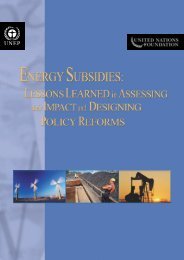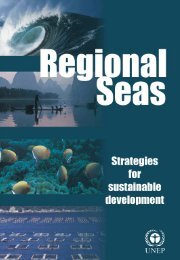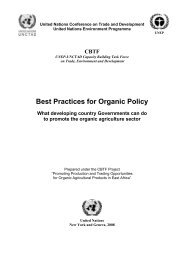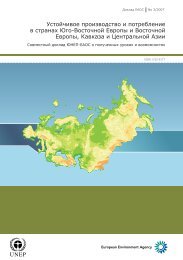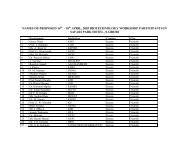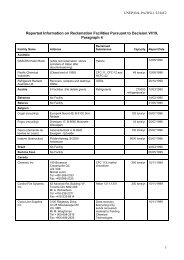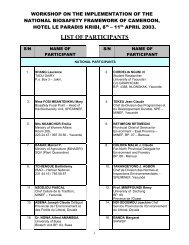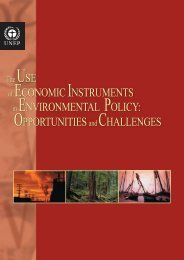Experiences in the first pulp mill project submitted to the ... - UNEP
Experiences in the first pulp mill project submitted to the ... - UNEP
Experiences in the first pulp mill project submitted to the ... - UNEP
Create successful ePaper yourself
Turn your PDF publications into a flip-book with our unique Google optimized e-Paper software.
<strong>Experiences</strong> <strong>in</strong> <strong>the</strong> <strong>first</strong> <strong>pulp</strong> <strong>mill</strong> <strong>project</strong><br />
<strong>submitted</strong> <strong>to</strong> <strong>the</strong> environmental impact<br />
assessment system <strong>in</strong> Chile<br />
Case Study 15<br />
Ana María Peña Alid<br />
The op<strong>in</strong>ions stated <strong>in</strong> this document are <strong>the</strong> sole responsibility of <strong>the</strong> author and do<br />
not necessarily reflect <strong>the</strong> op<strong>in</strong>ion of <strong>the</strong> National Commission on <strong>the</strong> Environment<br />
(CONAMA).<br />
ABSTRACT<br />
This case study concerns <strong>the</strong> <strong>first</strong> environmental impact assessment<br />
conducted on a cellulose <strong>project</strong> <strong>in</strong> Chile. The <strong>project</strong> site was <strong>in</strong> Sou<strong>the</strong>rn<br />
Chile (Region X). The facility was <strong>to</strong> discharge its effluents <strong>in</strong><strong>to</strong> <strong>the</strong> Cruces<br />
River, along <strong>the</strong> banks of which a Natural Reserve and a RAMSAR site are<br />
located.<br />
What follows is an analysis of <strong>the</strong> procedures established dur<strong>in</strong>g <strong>the</strong><br />
voluntary implementation of Environmental Impact Assessment <strong>in</strong> Chile,<br />
<strong>the</strong> benefits <strong>to</strong> be derived from us<strong>in</strong>g Terms of Reference, <strong>the</strong> assessment<br />
criteria that were taken <strong>in</strong><strong>to</strong> account <strong>to</strong> protect <strong>the</strong> sheltered area, and <strong>the</strong><br />
difficulties encountered <strong>in</strong> determ<strong>in</strong><strong>in</strong>g <strong>the</strong> significance of <strong>the</strong> ensu<strong>in</strong>g<br />
impacts.<br />
INTRODUCTION<br />
This document discusses <strong>the</strong> Review and Assessment of <strong>the</strong> Environmental<br />
Impact conducted on <strong>the</strong> Valdivia Project. The proposal was for <strong>the</strong><br />
construction of a new Kraft <strong>pulp</strong> <strong>mill</strong> with a 550,000 <strong>to</strong>nne/year output<br />
capacity, which would make a significant contribution <strong>to</strong> <strong>the</strong> national<br />
economy (<strong>in</strong>vestment is estimated at US1.3 billion), given <strong>the</strong> fact that it<br />
would generate major revenues from export sales on <strong>the</strong> world market.<br />
The <strong>in</strong>troduction of new <strong>pulp</strong> <strong>mill</strong> plants was highly probable given Chile’s<br />
vast forestry resources and current cellulose prices on <strong>the</strong> <strong>in</strong>ternational<br />
marketplace. Central and Sou<strong>the</strong>rn Chile, which present comparative<br />
advantages <strong>in</strong> terms of <strong>the</strong> proximity of raw materials and abundant<br />
watersheds – <strong>in</strong>dispensable for runn<strong>in</strong>g this type of <strong>in</strong>dustry – were<br />
particularly appropriate locations.<br />
The Environmental Impact Assessment for <strong>the</strong> Valdivia Project was of great<br />
significance given its voluntary nature and <strong>the</strong> geographical location and<br />
sheer magnitude of <strong>the</strong> <strong>project</strong>. It has established an important precedent for<br />
future environmental impact assessments. A salient feature of this <strong>project</strong> –<br />
See Topic 6<br />
<strong>UNEP</strong> EIA Tra<strong>in</strong><strong>in</strong>g<br />
Resource Manual<br />
Assess<strong>in</strong>g<br />
147<br />
<strong>UNEP</strong> EIA Tra<strong>in</strong><strong>in</strong>g Resource Manual ® Case studies from develop<strong>in</strong>g countries
<strong>the</strong> construction of a bleached Kraft <strong>pulp</strong> <strong>mill</strong> – is its location upstream from<br />
<strong>the</strong> Cruces River Natural Reserve and <strong>the</strong> discharg<strong>in</strong>g of effluents <strong>in</strong><strong>to</strong> this<br />
watercourse. This <strong>project</strong> had <strong>to</strong> be evaluated on <strong>the</strong> basis of extremely<br />
demand<strong>in</strong>g criteria which precluded even m<strong>in</strong>imal alterations <strong>to</strong> this<br />
Natural Reserve, which is <strong>in</strong>cluded <strong>in</strong> <strong>the</strong> RAMSAR Convention on<br />
‘Wetlands of International Significance, particularly as a habitat for<br />
Waterfowl’. This is <strong>the</strong> only stretch of Chilean wetland with <strong>the</strong> necessary<br />
characteristics for <strong>in</strong>clusion <strong>in</strong> this category. Fur<strong>the</strong>rmore, this Convention<br />
b<strong>in</strong>ds <strong>the</strong> State of Chile <strong>to</strong> place particular emphasis on <strong>the</strong> safeguard<strong>in</strong>g and<br />
protection of this ecosystem.<br />
The <strong>project</strong> was voluntarily <strong>in</strong>cluded <strong>in</strong> <strong>the</strong> Environmental Impact<br />
Assessment System (EIAS) <strong>in</strong> Oc<strong>to</strong>ber 1995, and it secured its environmental<br />
approval <strong>in</strong> May 1996. The assessment procedures used were <strong>the</strong> result of<br />
two years’ experience <strong>in</strong> both <strong>the</strong> public sec<strong>to</strong>r, which evaluates <strong>the</strong> <strong>project</strong>s,<br />
and <strong>the</strong> private sec<strong>to</strong>r, which conducts <strong>the</strong> Environmental Impact Study<br />
(EIS) and presents <strong>the</strong>m <strong>to</strong> <strong>the</strong> authorities for review purposes. For this<br />
specific <strong>project</strong>, <strong>the</strong> authorities issued Terms of Reference (ToR) <strong>to</strong> be used <strong>in</strong><br />
conduct<strong>in</strong>g <strong>the</strong> Study. The ToR established <strong>the</strong> m<strong>in</strong>imum content<br />
requirements for carry<strong>in</strong>g out an Environmental Impact Study (EIS).<br />
This case study addresses <strong>the</strong> particulars that were <strong>in</strong>volved <strong>in</strong> analyz<strong>in</strong>g<br />
synergistic and cumulative effects, <strong>the</strong> procedures used <strong>in</strong> review<strong>in</strong>g <strong>the</strong><br />
Environmental Impact Assessment, as well as <strong>the</strong> criteria and background<br />
<strong>in</strong>formation which served as <strong>the</strong> decision-mak<strong>in</strong>g basis <strong>in</strong> evaluat<strong>in</strong>g <strong>the</strong><br />
<strong>project</strong>’s effects on <strong>the</strong> ecosystem of <strong>the</strong> RAMSAR-protected Cruces River<br />
Natural Reserve.<br />
NATURE AND SCOPE OF ISSUES<br />
The Environmental Impact Assessment for this <strong>project</strong> was carried out at a<br />
time when Chile still lacked regulations for <strong>the</strong> establishment of consistent<br />
procedures and criteria <strong>to</strong> address this issue.<br />
Notwithstand<strong>in</strong>g <strong>the</strong> above, <strong>the</strong> Environmental Impact Assessment System<br />
(EIAS) considers that <strong>the</strong> environmental assessment of a <strong>project</strong> provides <strong>the</strong><br />
Regional Commission on <strong>the</strong> Environment (COREMA) with <strong>in</strong>formation<br />
deemed sufficient for that authority <strong>to</strong> issue a well-founded resolution that<br />
will assign a certa<strong>in</strong> environmental approval <strong>to</strong> <strong>the</strong> <strong>project</strong>. The<br />
requirements <strong>in</strong>clude a consideration of <strong>the</strong> technical aspects of <strong>the</strong> <strong>project</strong>, a<br />
balanced summary of <strong>the</strong> objections raised by <strong>the</strong> community, <strong>the</strong> measures<br />
promulgated <strong>in</strong> <strong>the</strong> mitigation, remediation and <strong>in</strong>demnification plans,<br />
environmental follow-up or moni<strong>to</strong>r<strong>in</strong>g, <strong>the</strong> environmental approval ei<strong>the</strong>r<br />
approv<strong>in</strong>g or reject<strong>in</strong>g <strong>the</strong> <strong>project</strong>, <strong>the</strong> environmental conditions or demands<br />
under which permits would be issued (if <strong>the</strong> <strong>project</strong> is approved) and<br />
mention of <strong>the</strong> public entities with competent jurisdiction <strong>in</strong> oversee<strong>in</strong>g and<br />
moni<strong>to</strong>r<strong>in</strong>g <strong>the</strong> <strong>project</strong>.<br />
148<br />
<strong>UNEP</strong> EIA Tra<strong>in</strong><strong>in</strong>g Resource Manual ® Case studies from develop<strong>in</strong>g countries
In o<strong>the</strong>r words, should <strong>the</strong> <strong>project</strong> be approved, it would not only receive its<br />
environmental qualification but also all related environmental permits.<br />
Failure by <strong>the</strong> EIA <strong>to</strong> <strong>in</strong>clude <strong>the</strong> necessary requirements or background<br />
<strong>in</strong>formation for <strong>the</strong> issu<strong>in</strong>g of <strong>the</strong>se permits will also prevent <strong>the</strong> authorities<br />
from issu<strong>in</strong>g an approval for <strong>the</strong> <strong>project</strong>.<br />
The ToR provided by <strong>the</strong> authorities for <strong>the</strong> conduct of this study failed <strong>to</strong><br />
render an accurate def<strong>in</strong>ition for, and limits <strong>to</strong>, <strong>the</strong> most relevant aspects of<br />
<strong>the</strong> assessment, <strong>in</strong>corporat<strong>in</strong>g all environmental components (climate and<br />
wea<strong>the</strong>r, air quality, geology, geomorphology, hydrology, water quality,<br />
vegetation and flora, fauna, socio-economic aspects, <strong>in</strong>frastructure,<br />
archaeology, landscape) and requir<strong>in</strong>g a detailed description of each<br />
component. The authorities’ lack of experience <strong>in</strong> determ<strong>in</strong><strong>in</strong>g <strong>the</strong> area of<br />
<strong>in</strong>fluence of <strong>the</strong> <strong>project</strong>, given its magnitude and location, accounts for <strong>the</strong>se<br />
difficulties. Moreover, s<strong>in</strong>ce <strong>the</strong> Valdivia Project was <strong>the</strong> <strong>first</strong> of its k<strong>in</strong>d<br />
(cellulose) <strong>to</strong> be <strong>in</strong>cluded <strong>in</strong> <strong>the</strong> EIAS, everyone was concerned that<br />
excessive zeal <strong>in</strong> def<strong>in</strong><strong>in</strong>g <strong>the</strong> limits of <strong>the</strong> requested data would lead <strong>to</strong> <strong>the</strong><br />
exclusion of important aspects from <strong>the</strong> assessment. Thus, <strong>the</strong> State would<br />
have been <strong>to</strong> blame for any impact generated by <strong>the</strong> <strong>project</strong> and not<br />
<strong>in</strong>cluded <strong>in</strong> <strong>the</strong> ToR.<br />
The <strong>project</strong> filed with <strong>the</strong> authorities for <strong>the</strong> issuance of ToR was by <strong>the</strong>n<br />
well def<strong>in</strong>ed, hav<strong>in</strong>g already established its exact location, <strong>the</strong> concept<br />
eng<strong>in</strong>eer<strong>in</strong>g and <strong>the</strong> technology <strong>to</strong> be used, i.e. a <strong>project</strong> not adaptive <strong>to</strong><br />
substantial modifications. There was also a preset timetable for <strong>the</strong> start-up<br />
of activities, construction and <strong>in</strong>stallation.<br />
The EIS for <strong>the</strong> Valdivia Project presented a description of a <strong>project</strong> at <strong>the</strong><br />
concept eng<strong>in</strong>eer<strong>in</strong>g stage. However, much detailed and <strong>in</strong>dispensable<br />
background <strong>in</strong>formation required for <strong>the</strong> grant<strong>in</strong>g of sec<strong>to</strong>r permits<br />
connected with <strong>the</strong> EIAS <strong>in</strong> Chile had not been <strong>in</strong>cluded.<br />
The Environmental Impact Assessment for this Study suffered from major<br />
shortfalls <strong>in</strong> <strong>the</strong> identification and analysis of <strong>the</strong> environmental effects<br />
aris<strong>in</strong>g from <strong>the</strong> <strong>project</strong>, particularly with regard <strong>to</strong> <strong>the</strong> Cruces River Natural<br />
Reserve. In this sense, <strong>the</strong> Study Basel<strong>in</strong>e was pa<strong>in</strong>fully <strong>in</strong>complete <strong>in</strong> most<br />
of its components (e.g. hydrology, water quality, aquatic vegetation and<br />
flora, land-based and aquatic fauna, socio-economic aspects), which<br />
precluded build<strong>in</strong>g a real scenario of <strong>the</strong> <strong>project</strong>’s area of <strong>in</strong>fluence and of<br />
<strong>the</strong> environment without <strong>the</strong> <strong>project</strong>.<br />
Fur<strong>the</strong>rmore, several fac<strong>to</strong>rs were not considered <strong>in</strong> <strong>the</strong> assessment, e.g. <strong>the</strong><br />
impact of emissions <strong>in</strong><strong>to</strong> <strong>the</strong> atmosphere (viz. <strong>the</strong> transformation of SO2 <strong>in</strong><strong>to</strong><br />
sulphuric acid) and <strong>the</strong> disposal and handl<strong>in</strong>g of solid waste<br />
generated by <strong>the</strong> <strong>project</strong>.<br />
PROCESS AND PROCEDURAL CONTEXT<br />
While <strong>the</strong> environmental impact assessment was be<strong>in</strong>g carried out, several<br />
aspects were considered that had been provided <strong>in</strong> <strong>the</strong> Environmental Law<br />
149<br />
<strong>UNEP</strong> EIA Tra<strong>in</strong><strong>in</strong>g Resource Manual ® Case studies from develop<strong>in</strong>g countries
which promulgated <strong>the</strong> EIAS as well as o<strong>the</strong>r <strong>in</strong>struments applicable with<strong>in</strong><br />
<strong>the</strong> context of <strong>the</strong> voluntary system and established by CONAMA.<br />
The follow<strong>in</strong>g aspects are significant:<br />
• ToR were laid down for <strong>the</strong> preparation of <strong>the</strong> EIS. The Study<br />
contemplates <strong>the</strong> environmental components that must be considered<br />
for assessment purposes and <strong>the</strong> m<strong>in</strong>imum requirements established<br />
by <strong>the</strong> authorities <strong>to</strong> review <strong>the</strong> EIS. However, this document carried<br />
no legal force <strong>to</strong> be established as a manda<strong>to</strong>ry requirement dur<strong>in</strong>g<br />
<strong>the</strong> review process. Under <strong>the</strong> Environmental Law, <strong>the</strong> authorities<br />
have 120 days <strong>to</strong> issue a <strong>project</strong>’s environmental approval. The<br />
follow<strong>in</strong>g action is taken dur<strong>in</strong>g this period:<br />
• <strong>the</strong> Environmental Impact Study is reviewed by <strong>the</strong> State bodies<br />
deemed environmentally competent by virtue of <strong>the</strong> characteristics of<br />
<strong>the</strong> <strong>project</strong>, its emplacement and potential <strong>to</strong> affect ei<strong>the</strong>r resources or<br />
communities protected under <strong>the</strong> Environmental Law. The follow<strong>in</strong>g<br />
entities participated <strong>in</strong> <strong>the</strong> review: Regional Plann<strong>in</strong>g and<br />
Coord<strong>in</strong>ation Office, Regional Water Bureau, Regional Highway<br />
Department, Regional Hous<strong>in</strong>g and Urban Development Office,<br />
National Forestry Corporation, Farm<strong>in</strong>g and Lives<strong>to</strong>ck Service,<br />
National Fish<strong>in</strong>g Service, National Tourism Service, Valdivia Public<br />
Health Bureau, and National Bureau of Maritime Terri<strong>to</strong>ries and<br />
Merchant Mar<strong>in</strong>e.<br />
• These entities reviewed <strong>the</strong> EIA <strong>in</strong> light of <strong>the</strong> established ToR and<br />
sec<strong>to</strong>ral criteria. They <strong>the</strong>n sent <strong>the</strong>ir comments <strong>to</strong> CONAMA and<br />
requested clarification or revision of EIS data which <strong>the</strong>y deemed<br />
necessary for a proper understand<strong>in</strong>g and assessment of <strong>the</strong> <strong>project</strong>.<br />
• CONAMA used <strong>the</strong> collected data <strong>to</strong> prepare a report <strong>in</strong> which it<br />
requested clarification, fur<strong>the</strong>r elaboration or revision of <strong>in</strong>formation<br />
from <strong>the</strong> applicant, po<strong>in</strong>t<strong>in</strong>g out <strong>the</strong> most serious shortcom<strong>in</strong>gs<br />
revealed by <strong>the</strong> Study.<br />
• Once <strong>the</strong> queries were answered and <strong>the</strong> problems resolved,<br />
CONAMA drafted a Technical Report on <strong>the</strong> basis of <strong>the</strong> reports<br />
issued by <strong>the</strong> competent entities. This Technical Report sets forth all<br />
relevant precedents from an environmental standpo<strong>in</strong>t, requisite<br />
action <strong>to</strong> comply with <strong>the</strong> environmental regulations, and confirms<br />
that <strong>the</strong> necessary background data has been furnished for <strong>the</strong><br />
issuance of <strong>the</strong> sec<strong>to</strong>ral environmental permits related <strong>to</strong> <strong>the</strong> <strong>project</strong>.<br />
Lastly, <strong>the</strong> competent authorities (COREMA) were called upon <strong>to</strong> give <strong>the</strong><br />
<strong>project</strong> an environmental qualification, <strong>in</strong>clud<strong>in</strong>g any applicable conditions<br />
or restrictions.<br />
150<br />
<strong>UNEP</strong> EIA Tra<strong>in</strong><strong>in</strong>g Resource Manual ® Case studies from develop<strong>in</strong>g countries
Based on <strong>the</strong> Study’s characteristics, <strong>the</strong> <strong>project</strong> owner was required <strong>to</strong><br />
clarify several aspects <strong>in</strong> connection with <strong>the</strong> <strong>project</strong>. Salient among <strong>the</strong><br />
problem areas were <strong>the</strong> follow<strong>in</strong>g:<br />
• The completion of <strong>the</strong> hydrology basel<strong>in</strong>e, which should at <strong>the</strong> very<br />
least consider water flow measurements dur<strong>in</strong>g a given annual cycle<br />
and <strong>in</strong>clude all seasonal fluctuations. This completion of <strong>the</strong> basel<strong>in</strong>e<br />
was of vital significance <strong>in</strong> assess<strong>in</strong>g <strong>the</strong> impact caused by <strong>the</strong><br />
diversion of water for runn<strong>in</strong>g <strong>the</strong> <strong>pulp</strong> <strong>mill</strong>, as well as <strong>the</strong> impact on<br />
water quality <strong>in</strong> <strong>the</strong> Cruces River due <strong>to</strong> effluent discharge.<br />
• The EIS only mentioned <strong>the</strong> eventual design of a sanitary landfill for<br />
<strong>the</strong> disposal of solid waste generated by <strong>the</strong> <strong>project</strong>. However, <strong>the</strong><br />
Study failed <strong>to</strong> provide any <strong>in</strong>formation on where <strong>the</strong> landfill would<br />
be located, <strong>the</strong> basel<strong>in</strong>e data, and <strong>the</strong> impact assessment for <strong>the</strong> site.<br />
The authorities demanded that fur<strong>the</strong>r <strong>in</strong>formation be delivered <strong>in</strong><br />
connection with <strong>the</strong> landfill for environmental impact assessment<br />
purposes. Moreover, <strong>the</strong> Public Health Bureau required <strong>the</strong> data <strong>in</strong><br />
order <strong>to</strong> issue <strong>the</strong> sanitary permit – sec<strong>to</strong>ral environmental permit –<br />
for <strong>the</strong> construction and operation of <strong>the</strong> waste site.<br />
• The air pollutants <strong>to</strong> be generated by <strong>the</strong> <strong>project</strong> would <strong>in</strong>clude 2.24<br />
<strong>to</strong>nne/day of particulate matter and 13.2 <strong>to</strong>nne/day of SO 2. These<br />
emissions would have an impact on air quality <strong>in</strong> terms of primary<br />
effects (human health) and secondary effects (natural resources). The<br />
EIS failed <strong>to</strong> provide an accurate determ<strong>in</strong>ation of <strong>the</strong> magnitude and<br />
extent of <strong>the</strong> impact generated by <strong>the</strong>se emissions.<br />
• This <strong>project</strong> provided for <strong>the</strong> arrival of 3500 people dur<strong>in</strong>g <strong>the</strong><br />
construction stage of <strong>the</strong> plant. Workers would lodge <strong>in</strong> <strong>the</strong><br />
communities neighbour<strong>in</strong>g <strong>the</strong> <strong>mill</strong> site, such as San José de la<br />
Mariqu<strong>in</strong>a, Lanco and Máfil, <strong>the</strong> largest of which had a population of<br />
merely 2500. A request was <strong>the</strong>refore filed <strong>to</strong> assess <strong>the</strong> socioeconomic<br />
and cultural impacts on that <strong>to</strong>wns, as well as <strong>to</strong> account for <strong>the</strong><br />
impacts caused by an eventual <strong>in</strong>crease <strong>in</strong> <strong>the</strong> demand for<br />
<strong>in</strong>frastructure and services.<br />
• One of <strong>the</strong> most problematic issues faced dur<strong>in</strong>g <strong>the</strong> environmental<br />
impact assessment was <strong>the</strong> presence of <strong>the</strong> RAMSAR site with<strong>in</strong> <strong>the</strong><br />
Project’s area of <strong>in</strong>fluence. In fact, this Reserve lies 30 km downstream<br />
from <strong>the</strong> <strong>mill</strong> site and is fed by <strong>the</strong> Cruces River. The Reserve operates<br />
under <strong>the</strong> auspices of <strong>the</strong> National Forestry Corporation (CONAF)<br />
151<br />
<strong>UNEP</strong> EIA Tra<strong>in</strong><strong>in</strong>g Resource Manual ® Case studies from develop<strong>in</strong>g countries
and is <strong>the</strong> only RAMSAR site <strong>in</strong> Chile, as ratified by an Executive<br />
Order issued <strong>in</strong> 1981.<br />
EIS results <strong>in</strong>dicate that <strong>the</strong> Reserve would be affected by <strong>project</strong>-related<br />
environmental impacts of moderate <strong>to</strong> m<strong>in</strong>or significance, <strong>in</strong> particular with<br />
regard <strong>to</strong> exotic nutrients which could possibly alter <strong>the</strong> ecosystem.<br />
Never<strong>the</strong>less, <strong>the</strong> public entities <strong>in</strong> charge of review<strong>in</strong>g <strong>the</strong> <strong>project</strong> refuted<br />
<strong>the</strong> accuracy of <strong>the</strong> assessment, s<strong>in</strong>ce <strong>the</strong> flow of exotic nutrients <strong>to</strong> <strong>the</strong><br />
Reserve would be far greater than those presented <strong>in</strong> <strong>the</strong> Study. The<br />
authorities <strong>the</strong>reafter demanded that <strong>the</strong> future impacts on <strong>the</strong> RAMSAR<br />
site be reassessed.<br />
APPROACH TAKEN<br />
Follow<strong>in</strong>g <strong>the</strong> official request for more <strong>in</strong>formation on <strong>the</strong> <strong>to</strong>pics mentioned<br />
above, <strong>the</strong> applicant delivered a revised Study that <strong>in</strong>corporated <strong>the</strong><br />
follow<strong>in</strong>g additional data:<br />
• Update and analysis of maximum water flows <strong>in</strong> <strong>the</strong> Cruces River.<br />
• Water quality moni<strong>to</strong>r<strong>in</strong>g programme <strong>to</strong> be carried out <strong>in</strong> <strong>the</strong><br />
summertime.<br />
• Information on solid waste disposal, which is still found deficient <strong>in</strong><br />
terms of eligibility for <strong>the</strong> respective permit. Not only was <strong>the</strong> location<br />
provided tentative <strong>in</strong> nature, but it was also outside <strong>the</strong> <strong>in</strong>fluence<br />
perimeter of <strong>the</strong> EIA <strong>project</strong>. The authorities were <strong>the</strong>refore unable <strong>to</strong><br />
render an op<strong>in</strong>ion on <strong>the</strong> environmental viability of <strong>the</strong> landfill.<br />
• The report mentions <strong>the</strong> synergistic effects on <strong>the</strong> Reserve produced<br />
by a comb<strong>in</strong>ation of fac<strong>to</strong>rs, such as <strong>the</strong> discharge of organic matter,<br />
<strong>in</strong>creased temperature and m<strong>in</strong>imum river flow. However, s<strong>in</strong>ce no<br />
data were provided <strong>in</strong> connection with this effect, <strong>the</strong> authorities were<br />
unable <strong>to</strong> determ<strong>in</strong>e whe<strong>the</strong>r an impact would be generated on <strong>the</strong><br />
receiv<strong>in</strong>g watercourse or not.<br />
• Data were furnished <strong>in</strong> connection with socioeconomic impacts, albeit<br />
still <strong>in</strong>sufficient for environmental assessment purposes.<br />
152<br />
The predicament of <strong>the</strong> Cruces River Natural Reserve merited <strong>the</strong> attention<br />
of <strong>the</strong> Head of <strong>the</strong> Special Policy Department of <strong>the</strong> Chilean Foreign Affairs<br />
M<strong>in</strong>istry, <strong>in</strong> order <strong>to</strong> clarify how Chile would live up <strong>to</strong> <strong>the</strong> environmental<br />
commitments assumed by <strong>the</strong> government when this Reserve qualified as a<br />
RAMSAR site. These obligations <strong>in</strong>clude <strong>the</strong> comprehensive protection and<br />
preservation of <strong>the</strong> conditions which make this site unique, and <strong>the</strong> Special<br />
Policy Department had <strong>in</strong> its possession data that revealed <strong>the</strong> fragility of<br />
this area as regards its self-preservation. Follow<strong>in</strong>g consultation with <strong>the</strong><br />
<strong>UNEP</strong> EIA Tra<strong>in</strong><strong>in</strong>g Resource Manual ® Case studies from develop<strong>in</strong>g countries
public entities related <strong>to</strong> <strong>the</strong> RAMSAR site, <strong>the</strong> Department concluded that<br />
<strong>the</strong> <strong>project</strong>’s features would generate environmental impacts <strong>to</strong> <strong>the</strong><br />
detriment of <strong>the</strong> aquatic environment and its biodiversity – <strong>in</strong> short, a<br />
violation of applicable environmental regulations.<br />
The work conducted by <strong>the</strong> public entities that participated <strong>in</strong> review<strong>in</strong>g <strong>the</strong><br />
Study was enhanced by <strong>in</strong>formation provided by some NGOs that <strong>to</strong>ok up<br />
this issue. The NGOs voiced <strong>the</strong>ir concern for <strong>the</strong> RAMSAR site and for<br />
certa<strong>in</strong> species that <strong>in</strong>habit <strong>the</strong> local ecosystem and are classified as<br />
endangered. Scientists and non-governmental organizations vehemently<br />
opposed <strong>the</strong> <strong>project</strong> and came <strong>to</strong> <strong>the</strong> defence of <strong>the</strong> Natural Reserve, argu<strong>in</strong>g<br />
that <strong>the</strong> effluents would be discharged <strong>in</strong><strong>to</strong> <strong>the</strong> river that runs through <strong>the</strong><br />
site and greatly impair its viability.<br />
On <strong>the</strong> o<strong>the</strong>r hand, <strong>the</strong> large <strong>in</strong>vestment sums considered for <strong>the</strong> <strong>project</strong> and<br />
<strong>the</strong> dist<strong>in</strong>ct possibility of new jobs engendered great expectations among <strong>the</strong><br />
local population. In recent years, <strong>the</strong> region had been mired <strong>in</strong> an important<br />
economic depression, and <strong>the</strong> potential new job sources <strong>to</strong> be generated by<br />
<strong>the</strong> <strong>project</strong> raised hopes that <strong>the</strong> situation would f<strong>in</strong>ally be reversed.<br />
F<strong>in</strong>ally, CONAMA issued a Technical Report conclud<strong>in</strong>g that – <strong>in</strong> light of<br />
<strong>the</strong> <strong>in</strong>formation furnished by <strong>the</strong> Environmental Impact Study – it was<br />
unable <strong>to</strong> qualify <strong>the</strong> <strong>project</strong> as environmentally viable, given that it had<br />
failed not only <strong>to</strong> demonstrate compliance with environmental regulations,<br />
but also <strong>to</strong> assure that <strong>the</strong> proposed mitigation action would fend off<br />
adverse effects on <strong>the</strong> quality and quantity of renewable resources, or on<br />
protected resources or areas of environmental value.<br />
RESULTS AND IMPLICATIONS<br />
The COREMA is <strong>in</strong> charge of assign<strong>in</strong>g environmental approvals <strong>to</strong> <strong>project</strong>s<br />
or activities, certify<strong>in</strong>g <strong>the</strong>ir viability from an environmental viewpo<strong>in</strong>t. The<br />
COREMA is a collegiate body made up of <strong>the</strong> Regional Intendant, <strong>the</strong><br />
Regional M<strong>in</strong>isterial Secretariat, <strong>the</strong> Prov<strong>in</strong>ce Governor, Regional<br />
Councilmen and <strong>the</strong> Direc<strong>to</strong>r of CONAMA. This particular COREMA made<br />
decisions about this <strong>project</strong> on <strong>the</strong> basis of <strong>the</strong> follow<strong>in</strong>g background<br />
<strong>in</strong>formation:<br />
• <strong>the</strong> Technical Report prepared and certified by <strong>the</strong> Technical<br />
Committee;<br />
• a balanced summary of <strong>the</strong> observations made by <strong>the</strong> local<br />
population; and<br />
• o<strong>the</strong>r considerations, such as regional and local development policies,<br />
public op<strong>in</strong>ion, an analysis of <strong>the</strong> social and economic costs and<br />
benefits that <strong>the</strong> <strong>project</strong> or activity would generate for <strong>the</strong> country,<br />
region, community, State etc., adherence <strong>to</strong> <strong>in</strong>ternational treaties etc.<br />
The Environmental Impact Assessment System (EIAS) is <strong>in</strong>tent on<br />
establish<strong>in</strong>g a uniform procedure <strong>to</strong> analyze environmental permits <strong>in</strong> any<br />
153<br />
<strong>UNEP</strong> EIA Tra<strong>in</strong><strong>in</strong>g Resource Manual ® Case studies from develop<strong>in</strong>g countries
s<strong>in</strong>gle <strong>in</strong>stance; <strong>the</strong>refore, <strong>the</strong> Technical Report must be conclusive <strong>in</strong> its<br />
determ<strong>in</strong>ation of whe<strong>the</strong>r <strong>the</strong> requisite data and requirements provided by<br />
law have been delivered <strong>in</strong> order for <strong>the</strong> competent environmental State<br />
authorities <strong>to</strong> issue <strong>the</strong> applicable permits. There was no way <strong>the</strong> Technical<br />
Report could be favourable for <strong>the</strong> <strong>project</strong> if <strong>the</strong> EIA lacked <strong>in</strong>formation that<br />
was necessary for a positive decision <strong>to</strong> be reached <strong>in</strong> connection with any<br />
particular permit. Such a departure from established procedure would have<br />
completely frustrated <strong>the</strong> orig<strong>in</strong>al <strong>in</strong>tent of <strong>the</strong> EIAS.<br />
The COREMA f<strong>in</strong>ally agreed <strong>to</strong> approve <strong>the</strong> <strong>project</strong>, albeit establish<strong>in</strong>g<br />
multiple environmental restrictions and <strong>the</strong> obligation <strong>to</strong> evaluate several<br />
<strong>project</strong> aspects environmentally.<br />
The Natural Reserve<br />
The Technical Report prepared by CONAMA, with data contributed by<br />
competent entities, concludes that <strong>the</strong> <strong>in</strong>formation furnished <strong>in</strong> <strong>the</strong> EIA and<br />
<strong>the</strong> review <strong>the</strong>reof by <strong>the</strong> Technical Committee precludes <strong>the</strong> mak<strong>in</strong>g of any<br />
assurances as <strong>to</strong> <strong>the</strong> presence or generation of impacts <strong>in</strong> <strong>the</strong> Natural<br />
Reserve. Even if <strong>the</strong> <strong>project</strong> were <strong>to</strong> adhere <strong>to</strong> <strong>the</strong> benchmark emission<br />
standards established for plant effluents, this safeguard would still fall short<br />
of prevent<strong>in</strong>g significant adverse impacts from be<strong>in</strong>g generated <strong>in</strong> terms of<br />
alterations <strong>to</strong> <strong>the</strong> characteristics of <strong>the</strong> protected site.<br />
The conditions which COREMA established <strong>in</strong> order <strong>to</strong> approve <strong>the</strong> <strong>project</strong><br />
were based on <strong>the</strong> Technical Report prepared by <strong>the</strong> Technical Committee,<br />
<strong>the</strong> additional background <strong>in</strong>formation furnished by <strong>the</strong> applicant and <strong>the</strong><br />
data <strong>in</strong>cluded <strong>in</strong> <strong>the</strong> <strong>project</strong>’s EIS. What follows is a detailed account of <strong>the</strong><br />
conditions.<br />
The <strong>in</strong>dustrial effluents from <strong>the</strong> <strong>pulp</strong> <strong>mill</strong> must be treated by <strong>the</strong> primary<br />
and secondary treatment systems provided <strong>in</strong> <strong>the</strong> EIS. Moreover, and with<br />
<strong>the</strong> <strong>in</strong>tention of protect<strong>in</strong>g <strong>the</strong> Natural Reserve and RAMSAR site, <strong>the</strong><br />
applicant will be required <strong>to</strong> opt for any of <strong>the</strong> follow<strong>in</strong>g alternatives for <strong>the</strong><br />
discharge of effluents:<br />
• discharge <strong>in</strong><strong>to</strong> <strong>the</strong> Cruces River, call<strong>in</strong>g for <strong>the</strong> <strong>in</strong>corporation of a<br />
tertiary treatment system that will operate on <strong>the</strong> terms <strong>to</strong> be<br />
established by COREMA; or<br />
• discharge <strong>in</strong><strong>to</strong> a stream or body of water o<strong>the</strong>r than <strong>the</strong> Cruces River<br />
and not directly communicat<strong>in</strong>g with, or flow<strong>in</strong>g <strong>in</strong><strong>to</strong>, <strong>the</strong> Natural<br />
Reserve.<br />
Fur<strong>the</strong>rmore, any option chosen would be subjected <strong>to</strong> an environmental<br />
assessment <strong>submitted</strong> for approval by COREMA. Regardless of which<br />
alternative <strong>the</strong> applicant chooses, <strong>the</strong> assessment must <strong>in</strong>clude a study of <strong>the</strong><br />
effects of consum<strong>in</strong>g a given amount of water from <strong>the</strong> Cruces River and<br />
discharg<strong>in</strong>g it <strong>in</strong><strong>to</strong> ano<strong>the</strong>r stream or body of water. All of <strong>the</strong> above is<br />
aimed at evaluat<strong>in</strong>g potential impacts on <strong>the</strong> Natural Reserve.<br />
154<br />
<strong>UNEP</strong> EIA Tra<strong>in</strong><strong>in</strong>g Resource Manual ® Case studies from develop<strong>in</strong>g countries
Disposal and treatment of solid <strong>in</strong>dustrial waste<br />
The applicant must implement a disposal system for solid <strong>in</strong>dustrial waste,<br />
<strong>to</strong> be located <strong>in</strong> a suitable area with<strong>in</strong> <strong>the</strong> limits which <strong>the</strong> EIS establishes for<br />
<strong>the</strong> <strong>mill</strong> site. This sanitary landfill must comply with all applicable<br />
environmental regulations and abide by <strong>the</strong> EIAS. A detailed profile on <strong>the</strong><br />
types and quantities of <strong>the</strong> waste <strong>to</strong> be dumped <strong>in</strong> <strong>the</strong> sanitary landfill must<br />
also be <strong>in</strong>cluded. Particular emphasis was placed on <strong>in</strong>formation regard<strong>in</strong>g<br />
<strong>the</strong> degree of <strong>to</strong>xicity of <strong>the</strong> waste and <strong>the</strong> compatibility among waste<br />
materials from a reactive po<strong>in</strong>t of view.<br />
Water supply and consumption<br />
Consumption of water from <strong>the</strong> Cruces River was limited <strong>to</strong> <strong>the</strong> maximum<br />
figure, established <strong>in</strong> <strong>the</strong> EIS, of 900 l/s, for both process and cool<strong>in</strong>g water.<br />
Also, should <strong>the</strong> water flow on <strong>the</strong> Cruces River border on <strong>the</strong> m<strong>in</strong>imum<br />
flow rate limits and/or be deemed by <strong>the</strong> General Water Bureau as cause for<br />
concern, <strong>the</strong> applicant must consult with CONAMA and <strong>the</strong> General Water<br />
Bureau for <strong>the</strong> implementation of measures conducive <strong>to</strong> <strong>the</strong> prevention of<br />
undesirable environmental impacts as soon as possible, <strong>in</strong> order <strong>to</strong> stave off<br />
irreparable damage <strong>to</strong> <strong>the</strong> aquatic environment.<br />
Emissions <strong>in</strong><strong>to</strong> <strong>the</strong> atmosphere<br />
It was recommended that <strong>the</strong> applicant consider <strong>the</strong> implementation of a<br />
control system for SO2 <strong>to</strong> reduce plant emissions. This measure cannot be<br />
imposed by <strong>the</strong> authorities as <strong>the</strong> <strong>project</strong> meets <strong>the</strong> environmental quality<br />
standards currently <strong>in</strong> force <strong>in</strong> Chile. However, emissions from <strong>the</strong> <strong>pulp</strong> <strong>mill</strong><br />
would create a zone where environmental quality would fall close <strong>to</strong> <strong>the</strong><br />
maximum authorized limit. This would be caused exclusively by <strong>the</strong><br />
<strong>in</strong>stallation of <strong>the</strong> <strong>mill</strong>, s<strong>in</strong>ce no o<strong>the</strong>r sources of this type of emissions exist<br />
<strong>in</strong> <strong>the</strong> vic<strong>in</strong>ity.<br />
Moni<strong>to</strong>r<strong>in</strong>g or follow-up plan<br />
Stations must be set up <strong>in</strong> areas adjo<strong>in</strong><strong>in</strong>g <strong>the</strong> Cruces River Natural Reserve<br />
and <strong>in</strong> <strong>the</strong> protected site itself dur<strong>in</strong>g <strong>the</strong> <strong>first</strong> three years of <strong>the</strong> plant’s<br />
operation, aimed at moni<strong>to</strong>r<strong>in</strong>g water quality. Standardized essays and<br />
pro<strong>to</strong>cols must be used with key Chilean species <strong>in</strong> order <strong>to</strong> account for <strong>the</strong><br />
effects on <strong>the</strong> Reserve’s ecosystem components.<br />
The applicant must constantly moni<strong>to</strong>r smokestack emissions and air quality<br />
for sulphur dioxide concentrations (SO2). Moreover, permanent moni<strong>to</strong>r<strong>in</strong>g<br />
of wea<strong>the</strong>r conditions is necessary <strong>in</strong> order <strong>to</strong> check <strong>the</strong> emission levels<br />
stipulated by <strong>the</strong> EIS and undertaken by <strong>the</strong> applicant.<br />
155<br />
<strong>UNEP</strong> EIA Tra<strong>in</strong><strong>in</strong>g Resource Manual ® Case studies from develop<strong>in</strong>g countries
LESSONS LEARNED<br />
Terms of Reference<br />
Several problems have arisen from <strong>the</strong> existence of ill-adapted ToR which,<br />
moreover, have no b<strong>in</strong>d<strong>in</strong>g force <strong>in</strong> so far as <strong>the</strong> preparation of <strong>the</strong> EIS<br />
(given <strong>the</strong> voluntary nature of this system) and are based on a<br />
predeterm<strong>in</strong>ed <strong>project</strong> that was conceived without any community<br />
<strong>in</strong>volvement. These issues are as follows:<br />
• a volum<strong>in</strong>ous Environmental Impact Study full of unnecessary<br />
details;<br />
• <strong>the</strong> relevant aspects of <strong>the</strong> <strong>project</strong> were identified dur<strong>in</strong>g <strong>the</strong> EIS<br />
review and not while prepar<strong>in</strong>g <strong>the</strong> ToR or <strong>the</strong> Environmental Impact<br />
Study;<br />
• loss of time and money because irrelevant or <strong>in</strong>applicable <strong>in</strong>formation<br />
is not deleted;<br />
• separate presentation of environmental impacts; not account<strong>in</strong>g for<br />
synergistic or cumulative effects from <strong>the</strong> comb<strong>in</strong>ation of<br />
environmental fac<strong>to</strong>rs and <strong>project</strong> emissions and discharges;<br />
• competent authorities must decide on <strong>the</strong> basis of <strong>in</strong>formation<br />
furnished by <strong>the</strong> Technical Report prepared by competent entities and<br />
relevant aspects for regional development, political and social fac<strong>to</strong>rs,<br />
among o<strong>the</strong>rs; and<br />
• Terms of Reference must be adapted <strong>to</strong> each specific <strong>project</strong>, s<strong>in</strong>ce<br />
<strong>the</strong>y assist <strong>in</strong> identify<strong>in</strong>g relevant impacts even prior <strong>to</strong> <strong>the</strong><br />
environmental assessment. They are also helpful <strong>in</strong> def<strong>in</strong><strong>in</strong>g <strong>the</strong><br />
practical areas <strong>in</strong> which <strong>the</strong> authorities shall require <strong>the</strong> applicant’s<br />
commitment.<br />
Significance of impact assessment<br />
The approval of any given <strong>project</strong> and <strong>the</strong> conditions established for its<br />
execution h<strong>in</strong>ge directly on how impact significance is <strong>in</strong>terpreted.<br />
Assessment criteria or methodologies used <strong>in</strong> this <strong>project</strong> were found<br />
want<strong>in</strong>g <strong>in</strong> <strong>the</strong> follow<strong>in</strong>g areas:<br />
• environmental quality and emission standards currently <strong>in</strong> force <strong>in</strong><br />
Chile (very few as of now);<br />
• fundamental criteria <strong>to</strong> allow for a broad and consensus-based<br />
comparison of aspects not currently regulated;<br />
• methodology guidel<strong>in</strong>es <strong>to</strong> focus environmental assessment on <strong>the</strong><br />
aspects deemed most relevant <strong>to</strong> this type of <strong>project</strong> and <strong>to</strong> <strong>the</strong><br />
emplacement <strong>the</strong>reof ; and<br />
• <strong>in</strong> <strong>the</strong> specific case of <strong>the</strong> Natural Reserve’s ecosystem, additional<br />
156<br />
<strong>UNEP</strong> EIA Tra<strong>in</strong><strong>in</strong>g Resource Manual ® Case studies from develop<strong>in</strong>g countries
assessment <strong>in</strong>stances had <strong>to</strong> be established that would <strong>in</strong>clude <strong>the</strong><br />
participation of environmental experts. The goal was <strong>to</strong> achieve<br />
consensus <strong>in</strong> assess<strong>in</strong>g <strong>the</strong> significance of <strong>the</strong> impacts and not leave<br />
this task <strong>to</strong> <strong>the</strong> decision-mak<strong>in</strong>g process, s<strong>in</strong>ce <strong>the</strong> latter takes nonenvironmental<br />
aspects <strong>in</strong><strong>to</strong> account.<br />
On <strong>the</strong> o<strong>the</strong>r hand, <strong>project</strong> owners must <strong>in</strong>clude environmental variables<br />
from <strong>the</strong> conceptual stage, and regard <strong>the</strong>m with <strong>the</strong> same relevance as <strong>the</strong><br />
technical and economic aspects. Incorporat<strong>in</strong>g environmental fac<strong>to</strong>rs <strong>in</strong> <strong>the</strong><br />
decision about <strong>the</strong> feasibility of a <strong>project</strong> affords <strong>the</strong> follow<strong>in</strong>g benefits:<br />
• determ<strong>in</strong><strong>in</strong>g a proper location for <strong>the</strong> <strong>project</strong> <strong>in</strong> order <strong>to</strong> dim<strong>in</strong>ish<br />
potential environmental impacts;<br />
• substantially m<strong>in</strong>imiz<strong>in</strong>g environmental degradation s<strong>in</strong>ce impacts<br />
are forestalled;<br />
• m<strong>in</strong>imiz<strong>in</strong>g potential conflict with affected communities or<br />
environmental activists;<br />
• expedit<strong>in</strong>g <strong>the</strong> Environmental Impact Assessment procedure; and<br />
• establish<strong>in</strong>g precedents <strong>to</strong> facilitate <strong>the</strong> environmental assessment<br />
process for o<strong>the</strong>r <strong>in</strong>ves<strong>to</strong>rs wish<strong>in</strong>g <strong>to</strong> participate <strong>in</strong> this type of<br />
<strong>project</strong>.<br />
DECISION-MAKING<br />
The follow<strong>in</strong>g is deemed necessary, given <strong>the</strong> characteristics of <strong>the</strong> <strong>project</strong>,<br />
Chile’s transition <strong>to</strong> democracy from an environmental standpo<strong>in</strong>t, and<br />
especially <strong>the</strong> evolution made by environmental impact assessments:<br />
• Keep <strong>the</strong> authorities (COREMA) <strong>in</strong>formed as <strong>to</strong> <strong>the</strong> progress be<strong>in</strong>g<br />
made <strong>in</strong> review<strong>in</strong>g <strong>the</strong> Environmental Impact Study, and <strong>the</strong> <strong>project</strong><br />
and <strong>the</strong> op<strong>in</strong>ion of <strong>the</strong> community most directly affected by it, prior <strong>to</strong><br />
mak<strong>in</strong>g <strong>the</strong> f<strong>in</strong>al decision, <strong>in</strong> order <strong>to</strong> keep undue pressures at bay.<br />
• Beg<strong>in</strong> <strong>the</strong> Environmental Impact Assessment process early enough <strong>to</strong><br />
allow for modifications.<br />
Key words<br />
• Support and streng<strong>the</strong>n <strong>the</strong> technical review of <strong>the</strong> EIS <strong>to</strong> reduce<br />
uncerta<strong>in</strong>ty when mak<strong>in</strong>g <strong>the</strong> f<strong>in</strong>al decision.<br />
The author:<br />
Ana María Peña Alid<br />
Dep<strong>to</strong>. de Evaluación de Impac<strong>to</strong> Ambiental CONAMA<br />
Obispo Donoso 6, Providencia<br />
Santiago<br />
CHILE<br />
susta<strong>in</strong>ability<br />
<strong>in</strong>tegrated<br />
approach <strong>to</strong> EIA<br />
process and<br />
procedures<br />
ecological and<br />
biological<br />
impacts<br />
157<br />
<strong>UNEP</strong> EIA Tra<strong>in</strong><strong>in</strong>g Resource Manual ® Case studies from develop<strong>in</strong>g countries



